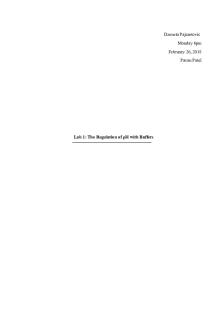Biochemistry 1 - biochem PDF

| Title | Biochemistry 1 - biochem |
|---|---|
| Author | Lance William Ramirez |
| Course | Biochemistry |
| Institution | Far Eastern University |
| Pages | 1 |
| File Size | 104.1 KB |
| File Type | |
| Total Downloads | 60 |
| Total Views | 136 |
Summary
biochem...
Description
AP Biology Unit 1: Biochemistry Cheat Sheet by hlewsey via cheatography.com/36676/cs/11528/
Properties of Water
Metabolism
Large Biomolecules
Polarity:
metabolic
a specific molecule that is altered
Carbohydrates
- allows cohesion, adhesion, surface tension
pathway
in defined steps catalyzed by
High Specific Heat:
enzymes that result in a certain
- resists temp change
product
- high heat of vaporization - allows evaporative cooling (high energy particles vaporize) Universal Solvent: - dissolves hydrophilic/ repels hydrophobic
catabolic
releases energy by breaking down
pathway
complex molecules
anabolic
consumes energy to build more
pathway
complex molecules
energy
the capacity to cause change or rearrange matter
Properties of Carbon
-monosacc h arides held by glycosidic linkages -energy storage, structure, protection Lipids -fatty acids held by ester linkages -hydrophobic, saturated/unsaturated, hormones Nucleic Acids -nucleotides held by phosphodiester H-
tetravalenc
4 bonds->complex molecules
Isomers
e
bonds -enable reproduction, controls protein
hydrocarbo
synthesis
C and H, release energy
ns
Proteins
structural
differs in covalent arrangement of
isomer
atoms
geometric
differs in spacial arrangements
isomer
around double bonds
enantiomer
mirror image of 4 molecules
-amino acids held by peptide bonds -follow varied instructions from DNA
attached to asymmetric carbon
Enzymes Laws of Thermodynamics
Enzymes these macromolecules act as catalysts that
1st Law of Thermodynamics
Functional Groups
energy can be transferred and transfo rmed -OH
hydroxyl
polar/hydrophilic
-CH3
methyl
nonpolar/hydrophobic
-COOH
carboxyl
polar/hydrophilic
-COH
carbonyl
-NH2
amino
2nd Law of Thermodynamics
Enzyme Activation -gene regulation= enzymes produced when needed
polar/hydrophilic
increases the entropy of the universe; a
-activators=cofactors (inorganic) and
polar/hydrophilic
process must increase entropy to be
coenzymes (organic) make up and help
spontaneous
enzymes function
sulfhydryl
nonpolar/hydrophobic
-PO4
phosphate
polar/hydrophilic
Acids and Bases increases H+ in solution
Enzyme Inhibition Free Energy Gibbs free energy- ΔG=ΔH-TΔS energy in a temp/pressure constant system that can perform work
Base
an induced fit w/substrate in the active site
every energy transfer/transformation
-SH
Acid
but not created or destroyed
lower activation energy barriers by forming
reduces H+ in solution (accepts H+or donates OH-)
pH
=-log[H+]
Buffer
accepts/donates H+ to stabilize pH
exergonic has a net release of free energy (-ΔG) endergonic absorbs free energy (+ΔG)
-competitive=in hibitor molecule binds to active site to block substrate -allosteric=inhibitor molecule binds to allosteric site to cover or change shape of the active site Optimal Conditions -enzymes have optimal temp+pH -cofactors+coenzymes bind to enzyme or substrate
ATP ribose, adenine, 3 phosphate groups hydrolyzed to ADP+Pᵢ phosphorylated molecules=more reactive
By hlewsey
Published 23rd April, 2017.
cheatography.com/hlewsey/
Last updated 23rd April, 2017.
Sponsored by CrosswordCheats.com Learn to solve cryptic crosswords!
Page 1 of 1.
http://crosswordcheats.com...
Similar Free PDFs

Biochemistry 1 - biochem
- 1 Pages

Biochem 215 lab 1
- 7 Pages

Chapter 1 - Biochemistry
- 4 Pages

Biochem - Disaccharide
- 6 Pages

Unit 1 Biochemistry SG
- 8 Pages

Biochemistry Week 1 Notes
- 10 Pages

Biochemistry cheat sheet 1
- 1 Pages

Biochemistry - Lecture notes 1
- 4 Pages

Biochem lab 1 - Lab report
- 6 Pages

Biochem ppt 1 - Lecture notes 1
- 16 Pages

Biochem- Finals
- 10 Pages

Biochem Ch. 1 - Chapter 1 Notes
- 8 Pages

Biochem 17
- 3 Pages
Popular Institutions
- Tinajero National High School - Annex
- Politeknik Caltex Riau
- Yokohama City University
- SGT University
- University of Al-Qadisiyah
- Divine Word College of Vigan
- Techniek College Rotterdam
- Universidade de Santiago
- Universiti Teknologi MARA Cawangan Johor Kampus Pasir Gudang
- Poltekkes Kemenkes Yogyakarta
- Baguio City National High School
- Colegio san marcos
- preparatoria uno
- Centro de Bachillerato Tecnológico Industrial y de Servicios No. 107
- Dalian Maritime University
- Quang Trung Secondary School
- Colegio Tecnológico en Informática
- Corporación Regional de Educación Superior
- Grupo CEDVA
- Dar Al Uloom University
- Centro de Estudios Preuniversitarios de la Universidad Nacional de Ingeniería
- 上智大学
- Aakash International School, Nuna Majara
- San Felipe Neri Catholic School
- Kang Chiao International School - New Taipei City
- Misamis Occidental National High School
- Institución Educativa Escuela Normal Juan Ladrilleros
- Kolehiyo ng Pantukan
- Batanes State College
- Instituto Continental
- Sekolah Menengah Kejuruan Kesehatan Kaltara (Tarakan)
- Colegio de La Inmaculada Concepcion - Cebu


